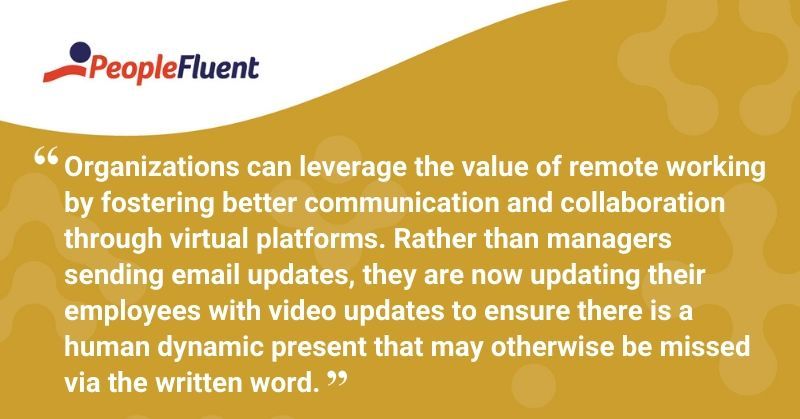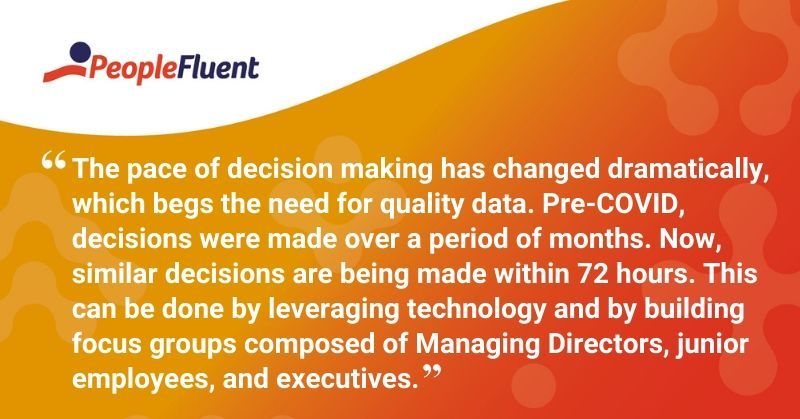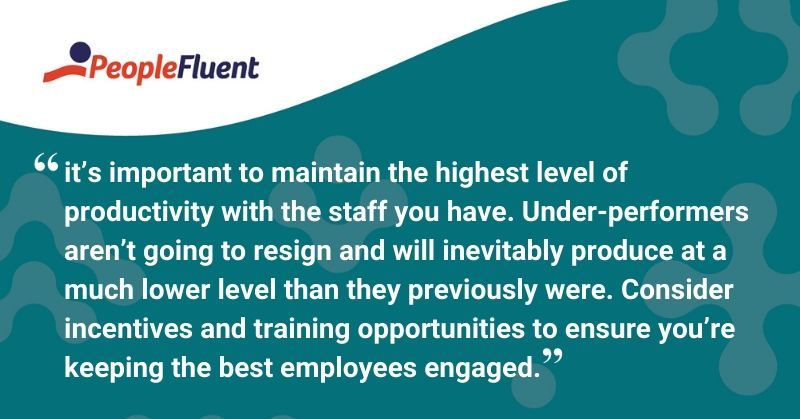Published: May 20, 2020Time to read: 8mins Category: Talent Management
How CHROs Can Maintain a Productive Workforce During Remote Work
As a large section of the world’s workforce adjusts to working remotely, CHROs must find a new normal to maintain a dedicated and productive workforce. Based on insights from the recent webinar, ‘The Rise of the CHRO: Q&A Session’, with guests Stephen Bruce, Managing Director at PeopleFluent, David Clift, Chief People Officer at LTG, and Jo Kori, Learning and Development Manager at LTG, we outline the ways in which a CHRO can embolden teams with a top-down approach by leveraging technology to drive productivity while working remotely.
Throughout this article, we provide answers to the questions many business leaders have had in regards to maintaining a productive workforce during remote work. We also look at what’s working and where HR professionals have room to improve. Finally, we provide insights on how HR professionals can help their employees and managers cope with the current state of work and keep the momentum going throughout the “new normal.”

You might also like: ‘Do Your HR Processes Align With the Depth of Your Technology?’
How Are CHROs Managing a New-Look Approach?
Based on insights from industry analyst and researcher, Josh Bersin, 95% of workers are remote due to recent lockdowns caused by the COVID-19 pandemic. With the uncertainty that surrounds our current state of work, and many companies unclear about when government officials will allow them to reopen, we raised the following questions to our guests:
Q: Although lockdown is an extreme situation, people are discovering benefits of working from home. As stay-at-home orders are lifted, more people may want to continue, at least partially, working remotely. How are CHROs managing this new-look approach to the workforce?
Stephen Bruce: The main consideration for CHROs is ensuring that the overall operations of a business are being managed effectively. One way to achieve this is by gathering the required HR metrics to justify remote work to the company’s executives. CHROs need to be aware of what the next set of data elements should be if a company decides to shift to a fully-remote workforce after the pandemic is over. It’s imperative to have HR analytics around how teams are performing and delivering results that help drive business outcomes.
Organizations can leverage the value of remote working by fostering better communication and collaboration through virtual platforms, like Google Meet video meetings. Automation and technology can and will help drive the decision for remote work. Rather than managers or CEOs sending email updates, they’re now updating their employees with video updates to ensure there is a human dynamic present that may otherwise be missed via the written word.
David Clift: For many companies that are geographically diverse, employees who were already working remotely before the pandemic are realizing an advantage of having their entire teams working from home. These individuals who previously felt disadvantaged by having two-thirds of their team working from the office, which provided better collaboration, are now feeling like equal participants. This is a bright spot for our organization, as well, as it has equalized the workforce and enabled people outside physical locations to feel as though they have more of an impact in meetings.
Another big change is that managers are no longer able to “manage by accident” by being physically near their employees, for example conversing with employees at the water cooler. Now, managers have been forced to act intentionally and really think about how objectives are being set and how the quality of work is being assessed. This takes us back to the critical need for gathering high-quality data in one place to ensure managers are capable of performing quality evaluations. Utilizing this data on an individual level as well as collecting data at the business level, such as pulse surveys, allows CHROs and other HR professionals to have rapid feedback at their fingertips. As businesses return to a new normal, HR professionals must hold onto these elements.
Jo Kori: As an early convert to remote work, I’ve been working from home for 18 years. At the beginning of this shift to remote work, there was a lot of concern about employees feeling isolated or whether they felt they could complete their job and remain productive. When we completed a recent employee survey at LTG, we asked employees what they liked about working remotely. Not surprisingly, 69.1% of people liked having more control over their day and the ability to find creative ways to get the work done. Further, employees reported an increased ability to complete their tasks.

Keep reading: ‘Retooling Talent Management: How HR Teams Can Engineer a New Era of Productivity’
Navigating the Rapid Decision-Making Process
With the shift from in-office to remote work occurring almost overnight, such a change may have caused vast anxiety across the business. Considering this rapid change, it’s important to ensure employees are constantly updated when additional changes are needed to protect the business.
Q: How are CHROs working through rapid decision-making on procedural changes and the various talent management functions?
David Clift: The pace of decision-making has changed dramatically, which begs the need for quality data. Pre-COVID, decisions were made over a period of months. Now, similar decisions are being made within 72 hours. This can be done by leveraging technology and by building focus groups composed of Managing Directors, junior employees, and executives. This diversity allows HR professionals to gather data and feedback across the business in real time which empowers CHROs to make the best decisions possible. Without these two key elements (data and a network of individuals), decisions could end up being lower quality.
Jo Kori: In our organization, internal communications have been vital for making quick policy changes. These communications have made it easier for employees to adopt the decisions and policies as they’re changing. Utilizing Google Forms to capture questions after weekly company updates and webinars has also become a vehicle for employees to provide feedback. Some of the feedback we’ve received from employees has highlighted their appreciation for the CEO’s transparency [through a weekly all-hands video call]. This top-down approach has been instrumental in increasing trust and transparency as well as an increase in loyalty across the business.

More from the blog: ‘3 Ways to Modernize Your Performance Review Process’
Utilizing Data Sets to Measure Performance
During the webinar, David Clift and Stephen Bruce outlined a high-level approach for utilizing data sets to measure performance. This strategy is especially critical for managers to navigate performance reviews during this time of remote work.
Q: How can specific data sets allow CHROs to make a high impact on the productivity and competitiveness of the organization?
David Clift: When I started in HR, the idea of having someone with data analytics skills on your team was never discussed. The skills required within an HR team now require people who can analyze data sets and ensure these results are useful. The ability to bring employee’s skills and competencies together in a simple tool is critical. In terms of productivity, the role of the CHRO has become much more important during this crisis. There’s an expectation to the board that you’re the person with the most important data. A lot of that info and data sits with HR and it’s an opportunity for HR professionals to show the importance of the positive impact on a business.
Stephen Bruce: Throughout my twenty years as an HR practitioner, CEOs have always worried about engagement and employee productivity. From that productivity perspective, there are no metrics to track how productive an employee is. Instead, HR professionals are relying on managers to understand how and why those engagement levels fall. If you don’t understand the engagement levels of your employees, you run the risk of reduced productivity. Pulse surveys can help businesses truly understand how the organization is performing during remote work.
Basic tracking can offer insights on whether HR should be thinking of incentives and compensation in a different way, like risk-based pay or other incentives. HR professionals need to be thinking of incentives and how they’re going to track that. Furthermore, it’s important to maintain the highest level of productivity with the staff you have. Under-performers aren’t going to resign and will inevitably produce at a much lower level than they previously were. Consider incentives and training opportunities to ensure you’re keeping the best employees engaged.
CHROs need to remind CEOs that if the business is down 15%-25%, it’s the responsibility of HR to bring organizational data through engagement surveys and performance metrics back to the management team to say: “This is how we’re forecasting and how it could impact our forecast for the rest of the year”.
To learn more about how to drive a more productive workforce for your organization, download a recording of the recent webinar, 'The Rise of the CHRO: Q&A Session'.
Discover How Performance Software Helps Build a Culture of Support
Guide people on a path of continuous improvement, excellence, and achievement. PeopleFluent helps you support your people, so they exceed their goals and drive business outcomes.